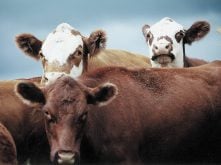This cattle market information is selected from the weekly report from Canfax, a division of the Canadian Cattlemen’s Association. More market information, analysis and statistics are available by becoming a Canfax subscriber by calling 403-275-5110 or at www.canfax.ca.
Fed cattle lower
The Canfax weighted average fed steer price was $174.44, down $5.58, and heifers were $173.23, down $5.96.
Most cattle were sold to Alberta packers, but there was some U.S. interest.
Read Also

Prairies have variable soil moisture conditions
The dry weather in the west was welcome for preserving grain quality and advancing harvest, but it has resulted in very dry soil moisture conditions.
Dressed sales were $292-$293 delivered. Most sales were scheduled for delivery in two to three weeks.
Steers have been sold early, and now a large offering of heifers are coming in behind.
The Alberta cash-to-futures basis weakened modestly to +$7.31 but remained strong for the season.
Weekly western Canadian fed slaughter to May 13 fell five percent to 34,613 head. Slaughter for the year is up five percent.
Weekly exports to May 6 rose to 5,507 head. For the year they are down 13 percent.
Fed steer carcass weights were 15-17 pounds lighter than the previous week.
Compared to the same week last year, Canadian steer carcass weights are down 49 lb. and U.S. weights are down 30 lb.
Market-ready supplies should increase modestly in the United States, and local supplies are expected to be steady.
Poor pen conditions in some feeding areas continue to affect performance and carcass weights, making it a challenge for packers to maintain production.
Lower beef cut-out values will likely pressure bids lower this week, but feedlots should maintain marketing leverage.
In the U.S., most live trade in the north was at US$134-$136 and in the south $132-$133. Prices were $2-$4 lower.
Dressed sales in the north were $212-213 delivered down $8-$10.
Cows lower
D1, D2 cows ranged C$100-$117 to average $109.40, down 43 cents. D3 cows ranged $86-$105 to average $97.50.
Alberta D1, D2 cow prices have fallen for two straight weeks and are now $1.50 off their annual highs. Rail grade cows ranged $205-$210.
Weekly Ontario prices rose $7 to the highest levels since July 2016.
Often cow slaughter declines into the spring, but looking at regional data, different stories are developing in Western and Eastern Canada.
Weekly western Canadian cow slaughter to May 13 totalled 4,785 head, the smallest this year.
In Eastern Canada, slaughter has topped 2,000 head for the past two weeks, the most since late January and early February.
Feeders rise
Canada’s feeder cattle prices continued strong even with volatility in the futures market and sharp declines in the fed market over the last two weeks.
May has been busier than normal for many commercial auctions. For the first three weeks of May volumes (including forward delivery sales) are up 26,000 head over last year.
Ontario feeder prices have rallied less than western Canadian prices.
On average, Alberta heifer prices are up $25 over the same time last year while Ontario heifers are down $4.50.
From their lows in February, 850 lb. steers have rallied 25 percent. This stands as the second largest first half rally seen in the past decade, topped only by 2014.
The basis for 850 lb. steers is the strongest this year. It was the fourth strongest weekly basis since 2014.
Alberta calf and feeder values have moved back to a premium over the U.S. market. This suggests cattle will stay in Western Canada.
Weekly feeder exports were only 2,032 head.
Cow-calf pairs averaged $2,600 per head with sales reported up to $3,475.
On average, cow-calf pairs are nearly $450 per head higher than last year. Pair prices usually decline into June.
The decline has averaged $100 per head, but it might be less this year because grass conditions are good across much of the Prairies. Also, strong calf prices are adding confidence to the market.
U.S. beef mostly lower
The Choice cutout was US$247.21 per cwt., up 35 cents, and Select was $221.66, down $5.
The Choice-Select spread widened to a record $26 as lighter carcass weights resulted in a large proportion of Select production. Also, demand for Choice middle meats was strong for barbecuing.
Buying for the U.S. Memorial Day weekend is wrapping up and beef prices could continue under pressure.
Canadian boxed beef prices for the week ending May 13 were C$297.01 per cwt. on AAA and $286.98 on AA.
There were 914,057 cattle in Alberta and Saskatchewan feedlots on May 1, the same as last year at the same time. It was the first time in nine months that inventories were equal with last year.
On-feed inventories have grown steadily over the past three months, partly because of bigger placements and historically low marketing volumes.
Placements in April were 128,832, up 25 percent over last year at the same time. It was the largest placement for the month since 2013.
Marketings in April were 105,099 head, down 10 percent from last year. It was the smallest for the month going back to 2000 when this report began. The marketings reflect steady domestic slaughter but a 35 percent decline in exports to the U.S.
Terminal feedlots have been buying grass cattle. These lighter stockers are entering feedlots much earlier than normal.
April placement of calves and stockers lighter than 700 lb. rose 66 percent, while feeders heavier than 700 lb. were up only 17 percent.
Heifers as a percent of total placements in April were 36.2 percent compared to 44.6 percent last year.
For the year, heifer placements are up 11 percent, or 19,000 head.














